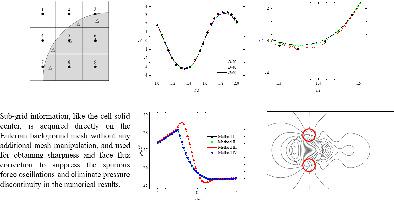当前位置:
X-MOL 学术
›
Int. J. Numer. Methods Fluids
›
论文详情
Our official English website, www.x-mol.net, welcomes your
feedback! (Note: you will need to create a separate account there.)
A consistent sharp interface fictitious domain method for moving boundary problems with arbitrarily polyhedral mesh
International Journal for Numerical Methods in Fluids ( IF 1.7 ) Pub Date : 2021-02-10 , DOI: 10.1002/fld.4965 Guoliang Chai 1 , Le Wang 2 , Zhaolin Gu 1 , Chunlei Yu 3 , Yigen Zhang 3 , Qinglin Shu 3 , Junwei Su 1
International Journal for Numerical Methods in Fluids ( IF 1.7 ) Pub Date : 2021-02-10 , DOI: 10.1002/fld.4965 Guoliang Chai 1 , Le Wang 2 , Zhaolin Gu 1 , Chunlei Yu 3 , Yigen Zhang 3 , Qinglin Shu 3 , Junwei Su 1
Affiliation

|
A consistent, sharp interface fully Eulerian fictitious domain method is proposed in this article for moving boundary problems. In this method, a collocated finite volume method is used for the continuous phase; a geometry intersection method is employed for numerical integrals over the solid domain and transport of the body force; the pseudo body force defined at “solid centers” ensures the algorithm consists of the body force between the continuous form and its discretization counterpart; an explicit flux correction on cell faces and resulting mass source is introduced into the continuity equation to lower noncontinuity errors in the velocity correction step. This method is valid for stationary and moving boundary problems with arbitrarily polyhedral mesh. Several numerical tests are carried out to validate the proposed method. A second-order spatial accuracy is found in the flow around a cylinder case, and the spurious force oscillation is well suppressed for the in-line oscillation of a circular cylinder case. The performances on different meshes are tested, and structured mesh yields the best result, polyhedral next, and tetrahedral worst. A serial of tests is further performed on structured mesh to verify the effect of three different features (i.e., storing the body force at the solid centers, flux correction, and whether including the body force in the momentum equation) on the numerical predictions. Numerical results show that, in the in-line oscillation of a circular cylinder, “flux correction” can eliminate the large spikes in the drag coefficient, and “including the body force in the momentum equation” helps suppress the small oscillations. For other tests, “storing the body force at the solid centers” has enormous impacts on the final results of moving boundary problems, “flux correction” has little effects and the necessity of “including the body force in the momentum equation” is case dependent.
中文翻译:

任意多面体网格移动边界问题的一致锐界面虚拟域方法
本文针对移动边界问题提出了一种一致的、清晰的界面完全欧拉虚拟域方法。在该方法中,连续相采用并置有限体积法;几何相交方法用于固体域上的数值积分和体力的传递;在“实体中心”定义的伪体力确保算法由连续形式与其离散化对应物之间的体力组成;单元表面的显式通量校正和由此产生的质量源被引入到连续性方程中,以降低速度校正步骤中的非连续性误差。该方法适用于任意多面体网格的静止和移动边界问题。进行了一些数值试验以验证所提出的方法。在圆柱壳周围的流动中发现了二阶空间精度,并且对于圆柱壳的直列振荡,寄生力振荡得到了很好的抑制。测试了不同网格上的性能,结构化网格的结果最好,多面体次之,四面体最差。进一步对结构化网格进行了一系列测试,以验证三种不同特征(即在实体中心存储体力、通量校正以及是否在动量方程中包含体力)对数值预测的影响。数值结果表明,在圆柱体的直线振荡中,“通量修正”可以消除阻力系数中的大尖峰,“在动量方程中包含体力”有助于抑制小振荡。对于其他测试,
更新日期:2021-02-10
中文翻译:

任意多面体网格移动边界问题的一致锐界面虚拟域方法
本文针对移动边界问题提出了一种一致的、清晰的界面完全欧拉虚拟域方法。在该方法中,连续相采用并置有限体积法;几何相交方法用于固体域上的数值积分和体力的传递;在“实体中心”定义的伪体力确保算法由连续形式与其离散化对应物之间的体力组成;单元表面的显式通量校正和由此产生的质量源被引入到连续性方程中,以降低速度校正步骤中的非连续性误差。该方法适用于任意多面体网格的静止和移动边界问题。进行了一些数值试验以验证所提出的方法。在圆柱壳周围的流动中发现了二阶空间精度,并且对于圆柱壳的直列振荡,寄生力振荡得到了很好的抑制。测试了不同网格上的性能,结构化网格的结果最好,多面体次之,四面体最差。进一步对结构化网格进行了一系列测试,以验证三种不同特征(即在实体中心存储体力、通量校正以及是否在动量方程中包含体力)对数值预测的影响。数值结果表明,在圆柱体的直线振荡中,“通量修正”可以消除阻力系数中的大尖峰,“在动量方程中包含体力”有助于抑制小振荡。对于其他测试,











































 京公网安备 11010802027423号
京公网安备 11010802027423号